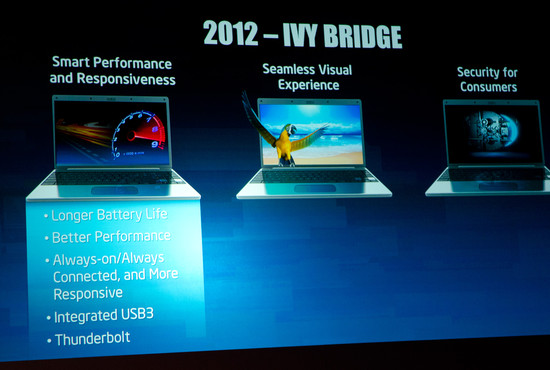Intel will launch the new mobile platform Chief River in Q2 2012. The star of the family is the new processor architecture Ivy Bridge that with its 22nm technology and tri-gate transistors (3D) will start a minor revolution in energy efficiency. Intel has now revealed that it will use this to bring variable power consumption and bring Thunderbolt to more people.
Ivy Bridge is more than just a “Tick” in Intel’s road map. Every other year comes “tick” launch where it has shrunk the architecture to a new node, and the next year comes a “tock”, which brings a new architecture on the same node. Intel says that Ivy Bridge with its new 3D transistors and other news will count as a Tick+ launch.

Intel’s base idea is that it will lower energy consumption overall with its mobile processors. From 35-45W to 10-20W. This is made a lot easier with Ivy Bridge’s new transistors and manufacturing technology, but at the same time Intel doesn’t want to lose the top performance of its mobile chips. To counteract this Ivy Bridge will ship with a variable TDP (Thermal Design Power) where it has used a new generation Turbo technology to challenge the nominal TDP.

The idea is to let the processors increase their frequencies so that the TDP will increase from say 15 watt to 35 watt. How long the circuit stays in the Turbo mode depends on the situation and the temperature. It could be a matter of seconds at heavy loads, or longer periods.
Intel sees great potential in its variable TDPs when looking at docking stations, with more juice and cooling available. The latter is something that could be a real gain for many users. Docking stations shouldn’t just be for continuous power and extra connectors, but also for cooling and performance.
Intel is expected to introduce the variable TDP with Ivy Bridge, but the next microarchitecture Haswell is expected to rely on the technology to a much higher degree.
Ivy Bridge gets USB 3.0 and Thunderbolt
With Ivy Bridge, Intel will also launch the first chipset with integrated SuperSpeed USB 3.0 support, but on top of that it will introduce its own high speed interface Thunderbolt integrated into the chipsets.
So far it’s only Apple that supports Thunderbolt on its platforms, but when Ivy Bridge arrives we will see a much speedier adaption.

Source: Intel, throug Anandtech















